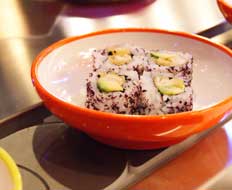The stereotypical mom and pop sushi restaurant is dimly lit and darkly paneled. YO!Sushi is not a stereotypical mom and pop sushi restaurant. Brightly lit and colorfully decorated with reds, oranges, and warm cedar, the successful U.K. restaurant chain, which opened its first U.S. location inside Washington, D.C.’s bustling Union Station in July, is hoping its poppy aesthetic will upend expectations and attract diners.
The restaurant’s layout likewise defies the standard. An open kitchen manned by four or five chefs is ringed by booths and counters, which are all serviced by a conveyor belt moving 3.1 inches per second. This helps patrons set the pace and duration of their dining experience.
“You can be done in 10 minutes, or you can stay for an hour,” says Alison Vickers, YO!Sushi’s director of business development.
The conveyor belt carries constantly refreshed color-coded plates implanted with radio-frequency identification (RFID) chips. These tracking devices ensure that nothing is in circulation for more than an hour. After 60 minutes, a robotic arm automatically picks off uneaten plates.
Clean, colorful, and eye-catching presentations are key. “If it looks good, you’re going to take it when it goes by,” Vickers says.
All of these factors should prove to be big selling points for the fast-casual chain, says David Kincheloe, president of National Restaurant Consultants.
“When you go into a restaurant, it’s not just about satisfying the need to eat,” he says. “It needs to be fun and entertaining. YO!Sushi came up with something unique, so I think people will like it.”
Servers hit each table for drink and soup orders and to answer questions. To further aid diners, placemats include a graphically driven instruction guide, while the menu offers pictures and descriptions for all items, broken down into categories like soups and broths, rice and noodles, tempura, sashimi, nigiri, rolls, and salads.
In another unorthodox move (at least for a sushi concept), YO!Sushi offers five desserts, including miso chocolate mousse with a crunchy crumbled biscuit base; a traditional Japanese matcha dorayaki, which is a green tea pancake with red bean filling; and a fresh fruit selection.
All told, there are more than 70 different dishes (including 17 vegetarian options) priced from $2.50 to $6 each. At the end of each meal, the empty dishware is tallied and added to any drink or soup orders placed with the server. On average, diners spend $18 each.
The Washington, D.C., location does not yet tackle the breakfast daypart, so it doesn’t open until 11 a.m. However, several of the international locations in transport hubs such as airports do offer grab-and-go breakfast items.
About 25 percent of the dishes available at the D.C. YO!Sushi are new or tweaked. For example, the chicken salad in the U.K. is made with thigh meat, but breast meat is used in the States to accommodate prevailing American tastes. Meanwhile, Spicy Popcorn Shrimp was added to the offerings due to its widespread popularity stateside.
“It’s important to listen to the local market,” Vickers says.
Kincheloe believes YO!Sushi has a good chance to entice consumers unfamiliar with sushi or unused to seeing it offered in a fast-casual environment.
“Most people will try something one time,” he says. “If they can win a first-time diner over with the quality of the product, the atmosphere, and the entertainment value, they may convert someone to sushi. Another factor in YO!Sushi’s favor is that people are much more willing to branch out. Fast casual isn’t just burgers anymore.”
As Kincheloe sees it, YO!Sushi is facing off against two major groups of competitors as it tries to turn an established U.K. brand into a U.S. favorite. “There’s the fast-casual group as a whole,” he says, “because that’s why people are going there—to get quality food quickly. The other competitors are going to be the local sushi places that have established names.”
The 15-year-old fast-casual chain is tackling the U.S. after successful forays into the Middle East and Norway and several years of research. “Finding the right partner was critical to us,” Vickers says.
The company found its match early last year when it was introduced to Richard Pawlowski, owner of The Sushi Company of North America. His firm already owns 37 Cosi, Qdoba, and Bugaboo Creek Steak House restaurants located along the Eastern Seaboard.
“He’s an established operator with good financing behind him,” Vickers says, “so he’s prepared to take big rents in high-profile locations, which is what we’ve done in the U.K.”
Washington, D.C., was chosen for the debut flagship location for pragmatic purposes, Vickers says. “It’s one of the best restaurant markets in the U.S.,” she says. “Plus, we wanted to do the East Coast first, so we could support it from the U.K. easily.”
The second stateside location will be just more than a mile away in D.C.’s high-traffic Chinatown neighborhood. The company plans on opening that unit at the end of this year or in early 2013. Beyond that, it is looking to bring outlets to transport hubs, high-traffic street locations, and shopping malls in Chicago, Dallas, Boston, and Miami.










